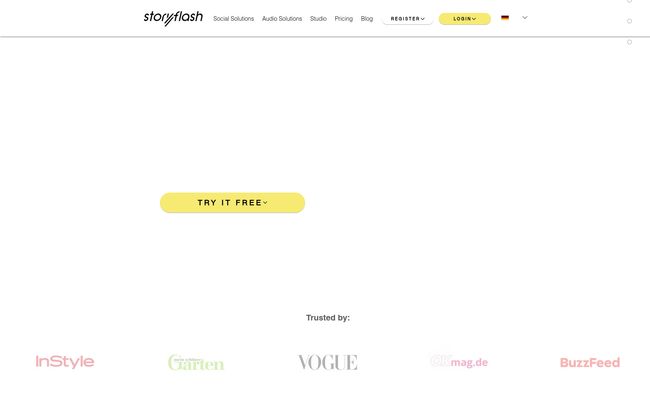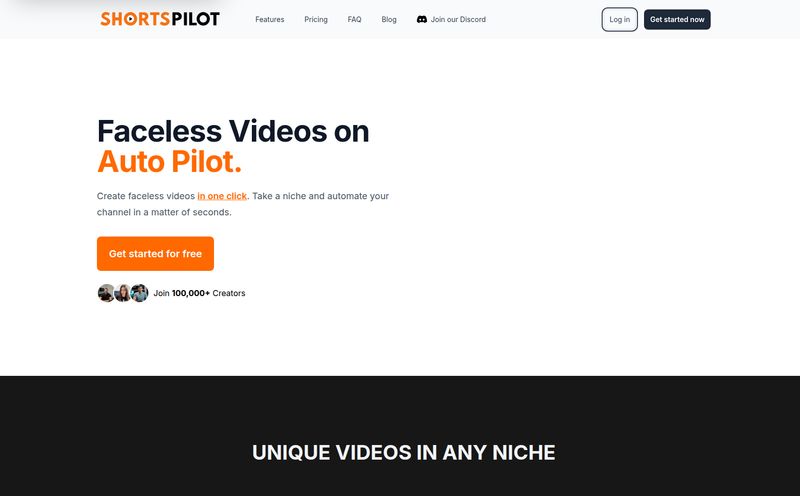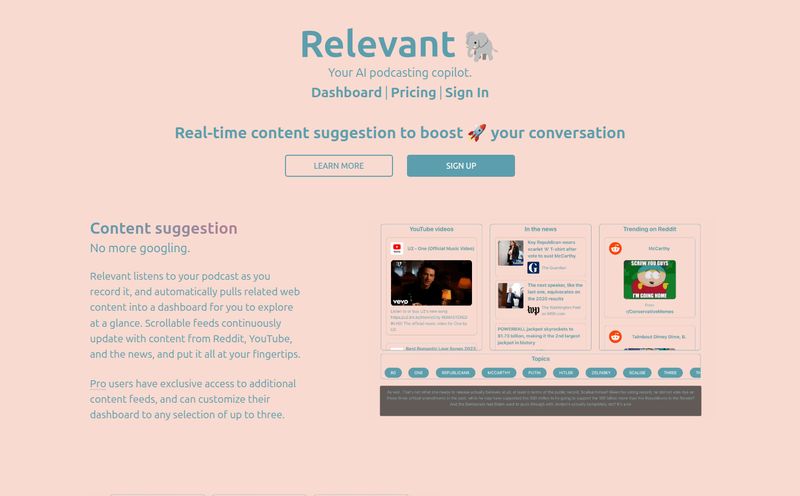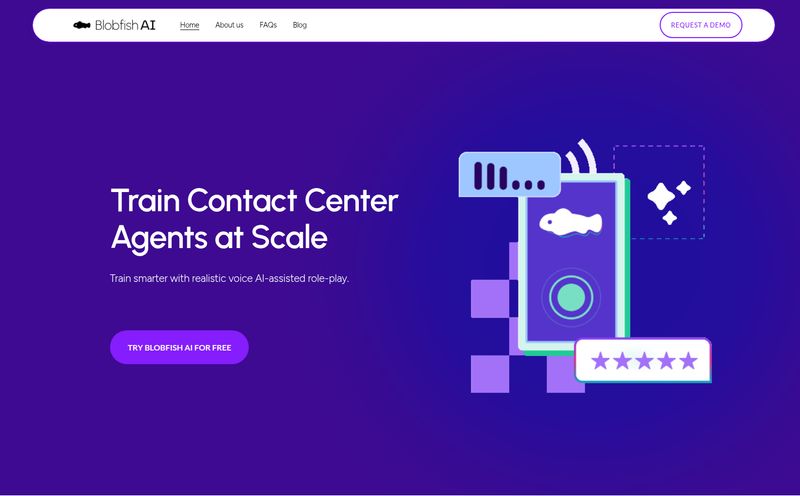The life of a content creator, a social media manager, or a publisher is a grind. It’s a never-ending treadmill of brainstorming, writing, editing, and—the part we all secretly dread—distributing. You finally hit ‘publish’ on that masterpiece of a blog post, only to realize you now have to slice and dice it for Twitter, create a graphic for Instagram, a different one for Facebook, and maybe, just maybe, if you have any energy left, think about a LinkedIn post. It’s exhausting.
And now, everyone's telling you that you need to be in audio. Podcasts are booming. Audio snippets on social media get crazy engagement. Your audience wants to listen to your content while they’re doing the dishes or stuck in traffic. Great. Just another thing to add to the to-do list, right? You've got to buy a mic, learn to edit audio, and find the time to actually record. Ugh.
I've been in this game for years, and I’ve seen countless tools promise to be the magic bullet. Most of them aren't. But every now and then, something comes along that genuinely makes me sit up and pay attention. Recently, that something was a platform called Storyflash.
First Off, What Is Storyflash, Really?
Okay, cutting through the marketing jargon. Storyflash is an automation tool designed to take your written content—like a news article or a blog post—and turn it into audio using synthetic voices. But it doesn't just stop there. It then takes that audio, packages it up into nice, shareable formats (think audiograms for your Instagram feed), and pushes it out to all your social channels and even podcast platforms. All on autopilot.
Think of it like a content assembly line for your ears. You feed it the text at one end, and out the other comes a steady stream of ready-to-post audio content. It's built for speed and efficiency, aiming to solve that massive bottleneck of content repurposing that we all face.

Visit storyflash
The Features That Actually Matter
A tool is only as good as its features, and Storyflash seems to have a few that directly address some major pain points for content teams. It's not just a one-trick pony.
From Silent Text to Engaging Audio
The core of the whole thing is its text-to-audio engine. You give it a URL, and it creates a newscast or audio version. Now, I know what you’re thinking: synthetic voices. I was skeptical too. We've all heard those robotic, monotone AI voices that make you want to rip your headphones off. And let's be clear, a synthetic voice will never have the same nuance as a seasoned voice actor. But the technology has come a long, long way. For daily news updates, short social snippets, or turning articles into an audio-accessible format, the quality is surprisingly good and it saves an unbelievable amount of time. No recording, no editing, no 'ums' and 'ahs'. Just clean audio, ready in seconds.
A True Distribution Powerhouse
This, for me, is where the real magic happens. Creating the audio is one thing; getting it everywhere is another. Storyflash lets you connect your Facebook, Instagram, LinkedIn, and podcast hosting accounts. You can then manage and schedule everything from one place. It’s not just about creating the asset; it’s about completing the entire workflow. You can set up custom distribution channels and precisely define your target audience for different types of content. That level of control is pretty impressive and a far cry from manually uploading files to a dozen different platforms.
All Your Content in One Place
It also features what they call a 'Content Inbox'. This acts as a central hub for publishers to manage, report on, and evaluate the content being produced. When you're running a high-volume operation, having this kind of command center is less of a luxury and more of a necessity. It prevents things from slipping through the cracks and gives you a bird's-eye view of your entire audio strategy.
Who Is This Really For?
So, should you run out and sign up? Well, it depends. If you're a solo blogger who posts once a month, this might be overkill. But if you fall into one of these categories, you should definitely be paying attention:
- News Publishers: This is a no-brainer. The ability to turn daily articles into daily audio briefs is a game-changer. It's no surprise they're trusted by brands like BuzzFeed and VOGUE.
- Content Agencies: Managing multiple clients with demanding content calendars? A tool like this could seriously streamline your workflow and offer a new, valuable service (audio content) to your clients.
- Brands with Active Blogs: Got a blog full of valuable content? Storyflash is a powerful way to repurpose that content and reach a new audience segment on social media and podcast platforms without a massive new investment in production.
- Busy Social Media Managers: If your main job is to keep social channels fed with fresh, engaging content, this gives you a whole new type of content to play with, largely on autopilot.
Let's Talk About the Price Tag
Alright, the all-important question: what's this going to cost? Storyflash uses a tiered subscription model, and while the prices are in Euros, the value proposition is pretty clear. They also offer a 14-day free trial, which is always a good sign.
| Plan | Price | Best For |
|---|---|---|
| Influence | €49 / month | Individuals or small businesses just dipping their toes into audio. Good for creating audiograms for stories and basic photo/text posts. |
| Social Suite | €550 / month | Serious social media teams and agencies. This unlocks all the audiogram options, synchronized podcasting, and crossposting. This seems like the sweet spot for many professional users. |
| Audio Suite | €625 / month | Those who are primarily focused on podcasting and pure audio distribution, like news agencies. |
| Full Suite | €799 / month | The all-in-one package for large publishers or enterprises. As they put it, it's "the only content tool you will ever need." It combines everything from the other plans. |
The jump from the Influence to the Social Suite plan is steep, no doubt. This clearly positions Storyflash as a professional-grade tool rather than a casual hobbyist app. The investment reflects the time-saving and scalability it offers to businesses that produce content at a high volume.
My Final Verdict: The Pros and Cons
After digging in, I've got some clear thoughts. On the plus side, the end-to-end automation is the biggest win. It's a genuine time-saver, taking a multi-step, multi-hour process and condensing it down to minutes. The ability to manage and schedule posts across so many channels from a single dashboard is a massive operational advantage.
On the other hand, the heavy reliance on synthetic voices might not work for every brand. If your brand voice is built around a very specific human personality, this could feel a bit impersonal. It's a trade-off between personality and scalability. Also, the pricing is clearly aimed at businesses, not individual creators, which might put it out of reach for some. But then again, you get what you pay for.
Frequently Asked Questions About Storyflash
Is Storyflash easy to learn?
Based on the user interface and testimonials praising its simplicity, it appears to be designed for ease of use. The goal is automation, so a complex UI would defeat the purpose. It seems built for busy teams who need to get up and running quickly.
Can I use my own voice instead of the synthetic ones?
The primary feature highlighted is the synthetic voice technology for speed and automation. The documentation doesn't prominently feature an option to upload your own voice, so it's safe to assume the platform is optimized for its own AI voices. This is a key part of its 'instant content' value proposition.
What social media and podcast platforms does it support?
The platform explicitly mentions seamless publishing to channels like Facebook, Instagram, and LinkedIn. It also has features for creating and distributing to podcast platforms, essentially allowing you to run a full-fledged podcast directly from your written content.
Is there a free trial for Storyflash?
Yes, they offer a 14-day free test phase. This is a great way to see if the workflow and the quality of the synthetic audio are a good fit for your brand before committing to a paid plan.
Is Storyflash worth the price?
This is the big one. If you're a business that spends significant hours and resources on content repurposing and social media management, the ROI can be huge. Calculate the number of hours your team would save. If that value exceeds the monthly cost, then it's absolutely worth it. For a solo creator, it's a tougher sell.
So, Should You Give It a Shot?
Here's the bottom line: The content creation landscape is getting more crowded and more demanding. Finding smart ways to work more efficiently isn't just a good idea; it's essential for survival. Storyflash presents a really interesting solution to a very real problem. It’s an ambitious tool that aims to automate a huge chunk of the content lifecycle.
If you're a publisher or a brand feeling the pressure to produce more content, especially audio, I think it's one hundred percent worth taking advantage of their 14-day trial. It might just be the thing that gets you off the content treadmill for good.



